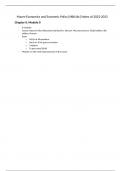Macro-Economics and Economic Policy [HBA16c] Notes of 2022-2023
Chapter 0: Module 0
- 6 modules
- Course material: Oliver Blanchard and David R. Johnson. Macroeconomics: Global edition. 8th
edition, Pearson
- Exam
o MCQs of 48 questions
o Starts at -8 for guess correction
o 4 options
o To pass need 28/48
- Module 2 is the most important part of the course
,Chapter 1: A tour of the world (Module 1)
- Macroeconomists look at and study:
o Output growth
o Unemployment rate
o Inflation rate
o Monetary policy
o Fiscal or budgetary policy
- Multiple crises in the recent decades
o The 2008 banking crisis
o 2012-2013 Greece
o 2020-20xx Covid crisis
- Looking at 4 areas:
o Euro Area
Tends to have high unemployment rate but a low inflation rate
o The US
Zero lower bound: an idea saying that interest rates cannot fall below zero
Tends to have higher inflation rate than euro zone, but lower unemployment
rate
o China
High population, a lot of output with a rapid growth
o Kenya
, Chapter 2: A tour of the world (Module 1)
- Aggregate output: total amount of output produced and supplied in the economy in a given
period
- Nominal GDP ($Y): the sum of the quantities of final goods produced times their current price
- Real GDP (Y): the sum of quantities of final goods times constant (not current) prices
- Example:
Nominal GDP in 2011: 10 × 20,000 = 200,000 Real GDP in 2011: 10 × 24,000 = 240,000
Nominal GDP in 2012: 12 × 24,000 = 240,000 Real GDP in 2012: 12 × 24,000 = 288,000
Nominal GDP in 2013: 13 × 26,000 = 260,000 Real GDP in 2013: 13 × 24,000 = 312,000
GDP
- GDP per capita =
Population
- Labor force (L): Employment (N) + Unemployment (U)
Labor force
- Labor force participation rate =
working age population
Employed
- Employment rate =
working age population
Enemployed U
- Unemployment rate = or u=
Labor force L
- Inflation is a sustained rise in the general level of prices – the price level.
- Deflation is a sustained decline in the price level.
- Consumer Price Index (CPI) is a measure of the cost of living
- Pure inflation is proportional increase in all prices and wages.
Okun’s law: measures the relationship between the unemployment rate and output
growth rate. The relationship is a negative relationship.
Philip’s curve: measures the relationship between the unemployment rate and
inflation rate. The relationship is a negative relationship.




